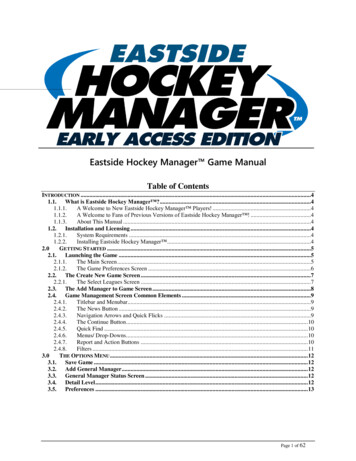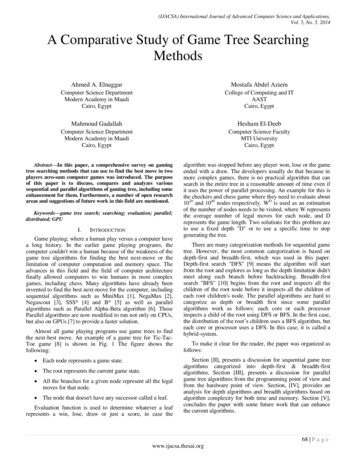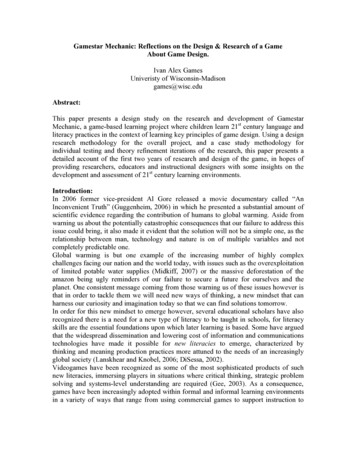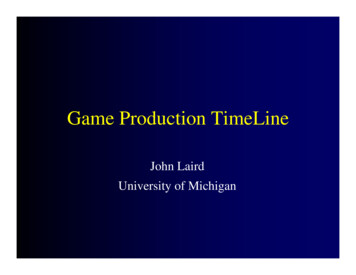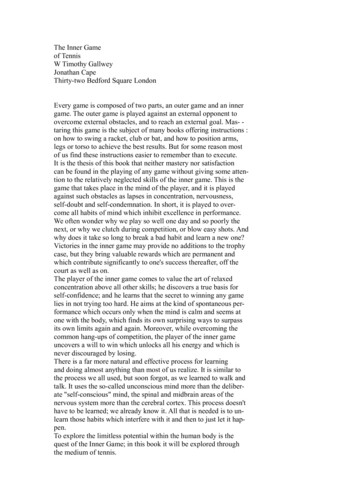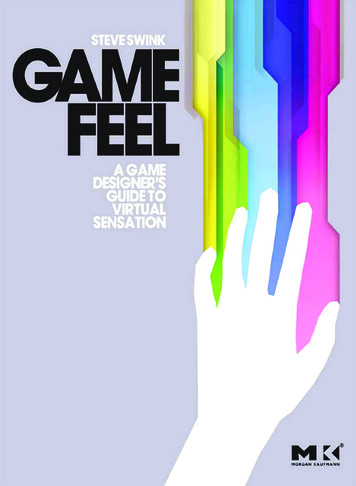
Transcription
Game Feel
Morgan Kaufmann Game Design BooksBetter Game Characters by Design (9781558609211)Katherine IsbisterGame Design Workshop, Second Edition (9780240809748)Tracy FullertonThe Art of Game Design (9780123694966)Jesse SchellGame Usability (9780123744470)Katherine Isbister & Noah Schaffer (Eds.)Game Feel (9780123743282)Steve Swink
Game FeelA Game Designer’s Guide toVirtual SensationSteve SwinkAMSTERDAM BOSTON HEIDELBERG LONDONNEW YORK OXFORD PARIS SAN DIEGOSAN FRANCISCO SINGAPORE SYDNEY TOKYOMorgan Kaufmann Publishers is an imprint of Elsevier
Morgan Kaufmann Publishers is an imprint of Elsevier.30 Corporate Drive, Suite 400, Burlington, MA 01803, USAThis book is printed on acid-free paper. 2009 Elsevier, Inc. All rights reserved.Designations used by companies to distinguish their products are often claimed as trademarks orregistered trademarks. In all instances in which Morgan Kaufmann Publishers is aware of a claim, theproduct names appear in initial capital or all capital letters. Readers, however, should contact theappropriate companies for more complete information regarding trademarks and registration.No part of this publication may be reproduced, stored in a retrieval system, or transmitted in any form orby any means—electronic, mechanical, photocopying, scanning, or otherwise—without prior writtenpermission of the publisher.Permissions may be sought directly from Elsevier’s Science & Technology Rights Department in Oxford,UK: phone: ( 44) 1865 843830, fax: ( 44) 1865 853333, E-mail: permissions@elsevier.com.You may also complete your request online via the Elsevier homepage (http://elsevier.com), by selecting“Support & Contact” then “Copyright and Permission” and then “Obtaining Permissions.”Library of Congress Cataloging-in-Publication DataSwink, Steve.Game feel: a game designer’s guide to virtual sensation/Steve Swink.p. cm.Includes index.ISBN 978-0-12-374328-2 (pbk. : alk. paper) 1. Computer games—Programming. 2. Computergames—Design. 3. Human-computer interaction.I. Title.QA76.9.H85S935 2009794.8’1526—dc222008035742ISBN: 978-0-12-374328-2For information on all Morgan Kaufmann publications,visit our Web site at www.mkp.com or www.books.elsevier.comPrinted in the United States of America08 09 10 11 12 13 10 9 8 7 6 5 4 3 2 1
DedicationFor people who struggle and make beautiful things
This page intentionally left blank
TABLE OF CONTENTSAcknowledgments.ixAbout the Author .xiIntroduction.xiii1. Defining Game Feel .12. Game Feel and Human Perception . 353. The Game Feel Model of Interactivity . 614. Mechanics of Game Feel . 695. Beyond Intuition: Metrics for Game Feel. 816. Input Metrics .1017. Response Metrics .1198. Context Metrics .1399. Polish Metrics .15110. Metaphor Metrics.17111. Rules Metrics .17912. Asteroids .187vii
TABLE OF CONTENTS13. Super Mario Brothers .20114. Bionic Commando .22915. Super Mario 64 .24716. Raptor Safari .27717. Principles of Game Feel.29718. Games I Want to Make.31119. The Future of Game Feel .321Indexviii.345
ACKNOWLEDGMENTSI would like to thank the following people.Mom & Dad, for their unwavering support of everything I do, ever. It must beexhausting. Special thanks to Dad for taking on the role of second editor, donatinghours and hours to proofreading, editing, writing first-pass chapter summaries andhelping me wrangle ideas. I love you guys. Thank you so much for being who youare. It gives me a standard to aspire to.Amy Wegner, for unflinching honesty in editing and for putting up with methroughout the months of craziness. Guess it’s my turn to do the laundry, bakecookies, do the dishes, take out the dog. Thank you for everything.Beth Millett, for being a kickass editor and for being the other person who had toput up with my craziness.Matthew Wegner, for help with the Raptor Safari, for many inspiring ideas aboutgame feel, and for being the stable foundation of Flashbang. You make everyonearound you better, smarter, faster and happier. We appreciate it, even if we don’ttell you so as much as we should.Mick West, for inspiring me to think about game feel at a deeper level. It washis article “Pushing Buttons” for Game Developer magazine that convinced methis would be a subject worth writing an entire book about, and he has graciouslyoffered me feedback and guidance when I asked for it. He is the true master ofgame feel. If you’re looking for someone to make your game feel better than anyoneelse can, ask him. I doubt he’ll say yes, but there it is.Allan Blomquist, for building pixel-perfect clones of old games and helping meunderstand how they work. Without Allan, the book would be much shorter.Derek Daniels, for the brilliant insights about the role of animation in game feeland the importance of hard metrics for game feel. I hope you write a book someday.Shawn White, for helping me with technical details about platformer games. Youtruly are the Captain of Rats.Matt Mechtley, for additional help with technical stuff and for the fantastic attitude. I hope you someday meet and woo fast women. It must be plural.Adam Mechley, for proofreading and helping me to achieve syntactic perfection.Kyle Gabler, for being brilliant and inspiring, and for helping me understand theimportance of sound and its role in game feel. I hope I can someday be half as gooda game designer as you are.Ben Ruiz, for making me laugh and smile always. You provide a constantreminder why we do what we do.ix
ACKNOWLEDGMENTSJon Blow, for inspiring everyone to make better games and for teaching me aboutproxied embodiment.Kellee Santiago and Jenova Chen, for making beautiful things and for taking thetime to talk to me about how.Chaim Gingold, for making brilliant things and for taking the time to talk to meabout how.Katherine Isbister, for the encouragement and opportunity to write a book.x
ABOUT THE AUTHORSteve Swink is an independent game developer, author and lecturer currentlybased in Tempe, Arizona. As a game designer and partner at Flashbang Studios,he’s contributed to games such as Off-Road Velociraptor Safari, Splume, JetpackBrontosaurus, and Minotaur China Shop. Before joining Flashbang, he toiled in theretail game mines at Neversoft and the now-defunct Tremor Entertainment. He alsoco-chairs the Independent Games Festival, is an IGDA Phoenix chapter coordinator, and teaches the game and level design classes at the Art Institute of Phoenix.He sometimes forgets the importance of sleeping every night, not just some.xi
This page intentionally left blank
INTRODUCTIONClose your eyes for a few seconds and imagine yourself playing Super MarioBrothers.What did you imagine? The visuals? The colors? The iconic sounds of coin collecting and the Mario theme music? How about the sensation of moving Mario left andright, of jumping, colliding with blocks, stomping Goombas? What does it feel liketo control Mario? Go watch someone unfamiliar with games—your mom, perhaps—try to play a game like Rad Racer. If it’s a game which requires real-time control,she’ll be leaning left and right in her chair, pulling the controller, trying to get thecar to move just a bit farther, a bit faster. Ever seen someone do this? Done it yourself? This feeling of steering—this tactile, visceral sensation—is game feel.For the purposes of this book, “feel” is meant in a very specific sense relevant tothe experience of playing video games. Feel is not meant in the thematic sense (aWestern feel, a Baroque feel) or in the expressive, emotional or physical sense (I feelsad, I feel pain, this place feels creepy). Specifically, game feel is the tactile, kinesthetic sense of manipulating a virtual object. It’s the sensation of control in a game.In digital game design, feel is the elephant in the room. Players know it. Designersknow of it. Nobody talks about it, and everybody takes it for granted. It’s not hardto understand why; if a game designer’s done his or her job correctly, the player willnever notice the feel of a game. It will just seem right. In this sense, game feel is an“invisible art,” like cinematography. Feel is the most overlooked aspect of gamecreation; a powerful, gripping, tactile sensation that exists somewhere in the spacebetween player and game. It is a kind of “virtual sensation,” a blending of the visual, aural and tactile. In short, it is one of the most powerful properties of humancomputer interaction.Recently, I had the opportunity to play Spacewar!, the world’s first video game1at the “Game On!” exhibit at the Tech Museum, in San Jose, California. What struckme is just how compelling the game still is. It’s easy to imagine the breathlessenthusiasm of the young technicians crowding around their PDP-1 supercomputer,exhausting hours of valuable computing time on endless rounds of Steve Russell’screation. Even today, as a product of a video game culture, having played hundredsof games, it feels great to me to steer the little rockets, fire off missiles and avoidblack holes. Game feel has been with us since the beginning.1William Higinbotham’s Tennis (1958) is also a contender, but Spacewar! was the first to have something approximating modern game structure—rounds, scoring and so on.xiii
INTRODUCTIONIt may be easy to bring to mind, but game feel is difficult to understand. Gamesare a nascent and complex medium, one which incorporates many previous forms.A single game might include painting, music, cinematography, writing and animation.If that weren’t enough, video games represent an unprecedented collaborationbetween creator and consumer. We abdicate authorial control to our players andget something. We’re not quite sure what yet, but we know that it has potential.To many, interactivity seems to be the most important medium of the 21st century.It’s surprising, then, that the luminaries of digital game design have devoted little ink to the phenomenon of feel. In Rollings and Morris, any mention of feel isconspicuously absent. Salen and Zimmerman dance tantalizingly close to discussing feel, but take a more holistic approach, focusing on game state at the higherintervals where scoring and more traditional strategic considerations occur. ChrisCrawford’s revered work, The Art of Computer Game Design, devotes only a sentence to game feel, saying “The input structure is the player’s tactile contact withthe game; people attach deep significance to touch, so touch must be a rewardingexperience for them.”With due respect to these authors and all the great stuff they have taught us,what’s missing is an appreciation of just how unique and beautiful an aestheticgame feel truly is. It exists outside of video games—driving cars, riding bikes and soon—but nowhere is it so refined, pure and malleable.In addition, game feel is moment-to-moment interaction. If we examine thefunctional underpinnings of most video games, there is usually game feel at the mostbasic level. It has greater importance in certain games but it’s always there. As a percentage of activities in the game, it’s what you spend most of your time experiencing. If you break down all the activities of a game, it’s the biggest slice of the pie.This book is about examining feel in greater detail. Where does it come from?How is it created? Does it exist in the computer, the player’s mind or somewhere inbetween? What are the different kinds of feel and why do they feel the way they do?In a clear, non-technical style intended to be accessible to professionals, players andaspiring designers alike, we will investigate feel as experienced by players, created bydesigners and measured by psychologists. The goal is to create a comprehensive guideto game feel: deconstructing it, classifying it, measuring it and creating it. By book’send you will have the tools to measure, master and create exemplary game feel.About This BookThis book is about how to make good-feeling games. In many ways, it’s the bookI wanted when I first started designing games. So many creative ideas rely on afoundation of good-feeling controls. It should be a given that we can always createcontrols that feel good. We shouldn’t have to start from scratch every time.This book constructs a foundation of understanding and then builds on it,addressing at each step a particular gap in the knowledge base about game design.Figure I.1 shows the structure and flow of the book’s topics.xiv
INTRODUCTIONFIGUREI.1 The structure and flow of the book.www.game-feel.comTo get the most out of reading Game Feel, I recommend going to www.game-feel.com,the companion website to this book. For many of the chapters, I’ve provided playable examples that will allow you to experience first-hand the ideas being discussed.In addition, the website contains interviews on the subject of game feel with folkslike Kellee Santiago and Jenova Chen of thatgamecompany, Kyle Gabler of 2dBoy,and Johnathan Blow and Chaim Gingold of Number-None and Maxis, respectively.If you’re a student, the definition at the beginning will be interesting and relevant, but the real meat will be the examples. In the examples you can see all thetiny decisions and particulars of implementation that go into making games feel theway they do. This is the palette of game feel; if you want to make good-feelinggames, these are the details you need to understand.If you’re a game designer, the definition stuff will not be news to you. But some ofthe theory bits may be useful and applicable, if only to better understand the deeperphysiological phenomena. The examples will be useful because of the legwork I’vealready done—you can reverse engineer games yourself, probably, but it takes a lotof time. The principles of game feel may also be a useful way to think about building games. It’s one way, at any rate, to which you can compare your own methods.2If you’re an educator, the theory and definition pieces form a solid basis forunderstanding game feel at a conceptual level. In addition, the examples provide agreat way to illustrate the complexities of making good-feeling games without forcing students to program the games themselves from scratch. The most useful part,2Which, by the way, I’d love to hear about. Email me at sswink@flashbangstudios.com.xv
INTRODUCTIONhowever, will probably be the principles of game feel chapter, which lays out someguidelines for creating good-feeling games.If you’re someone interested in the medium of games, such as a journalist, thedefinition parts may provide a new perspective on genres. In addition, understandingthe physiological thresholds that cause game feel to be sustained or break downmay help explain why frame rate drops and other technical disturbances makegames feel so much worse. But my hope is that in understanding and being ableto measure things like frame rate and response time, you will be able to do a betterjob of separating medium from message. Yes, a developer is to blame if a game runspoorly. But I think this consideration is given too superlative an emphasis whengames are critiqued. The experience of playing a game may still have some thingsto offer from a critical standpoint—as Jurassic Park: Trespasser did—even if they aretechnically incompetent.What Is Game Feel?One obstacle to understanding game feel at a deeper level is definition. This sectionoffers a simple three-part definition of game feel based on the ways players experience it and game designers design it.Each of the three parts of the definition is expanded to make it useful for classifying games as well as understanding what game feel is. Expanding the definitionrequires an exploration of some of the ways people perceive things, including measures for frame rate, response time and other conditions necessary for game feel tooccur. These physiological thresholds and concepts of perception combine to formthe “game feel model for interactivity”—a complete picture of the ongoing processof game feel.The section ends by applying the definition to some games specifically chosenbecause they are on the fringes of game feel.Metrics for Game FeelAnother problem facing game designers is meaningful comparison. How does thefeel of Halo compare to the feel of Ikaruga? From a designer’s perspective, this istied to tuning. Why is one game “floaty” while another is “tight and responsive”? Ifa player tells me that my game is floaty, what should I do? How should I change thevariables of my complex system? Is floaty bad? Is it good? What does it mean?This section is about measuring the pieces of the game feel process that adesigner can change. By measuring each piece—input, response, context, polish,metaphor and rules—we can make generalizations about what terms like floaty,tight, smooth, responsive and loose mean. Not only in a particular game, but acrossdifferent games. Once we can measure game feel, we can master it.xvi
INTRODUCTIONPractical ExamplesThe metrics we developed in Section II are applied to specific games, providingcomprehensive analysis of how the feel of these games function and providinga template for creating games with similar feel. This section will give you clear,practical steps for creating a game that feels a particular way. In addition, I haveconstructed playable and editable examples for each game (find them at www.game-feel.com) so you can follow along and experience how the feel of each gamechanges and grows.Principles of Game FeelWhat principles, if followed, will make all games feel better? This section generalizes the lessons of the good-feeling examples and measurable pieces of game feelinto a set of best practices for game feel.The Future of Game FeelThis section uses the lessons and definitions of the previous chapters to examinethe input devices, rendering technology and thought problems that will define howgame feel will be used in the future. With deep, expressive interactivity, can we provide experiences which don’t require the backdrop of skill and challenge? Is it possible to express things spatially without competition? Could game feel be a form ofdeeply personal expression like dance or martial arts?xvii
This page intentionally left blank
ONECHAPTERDefining Game FeelThere is no standard definition of game feel. As players and game designers, wehave some beginnings of common language, but we have never collectively definedgame feel above what’s necessary for discussing a specific game. We can talk aboutthe feel of a game as being “floaty” or “responsive” or “loose,” and these descriptions may even have meaning across games, as in “We need to make our game feelmore responsive, like Asteroids.” But if I ask 10 working game designers what gamefeel is—as I did in preparation for writing this book—I get 10 different answers. Andhere’s the thing: each of these answers is correct. Each answer describes a differentfacet, a different area, which is crucial to game feel.To many designers, game feel is about intuitive controls. A good-feeling game isone that lets players do what they want when they want, without having to think toomuch about it. Good game feel is about making a game easy to learn but difficult tomaster. The enjoyment is in the learning, in the perfect balance between player skilland the challenge presented. Feelings of mastery bring their own intrinsic rewards.Another camp focuses on physical interactions with virtual objects. It’s all abouttiming, about making players really feel the impact, about the number of frameseach move takes, or about how polished the interactions are.Other designers insist that game feel is all about making the players feel as thoughthey’re really there, as though they’re in the game. All their efforts go into creatinga feel that seems more “realistic” to players, which somehow increases this sense ofimmersion, a term that is also loosely defined.Finally, to some designers, game feel is all about appeal. It’s all about layeringon effect after careful effect, polishing every interaction—no matter how trivial—until interacting with the game has a foundation of aesthetic pleasure.The problem is unity. How do these experiences become a cohesive whole?They all tell us something about game feel, but they do not help us define it. St.Augustine’s comment about defining time comes to mind: “What then is time? Ifno one asks me, I know what it is. If I wish to explain it to him who asks, I do notknow.”Game feel is the same way. Without close examination, we know what it is. Tryto define it and the explanation quickly unravels into best practices and personalexperiences.1
CHAPTER ONE DEFINING GAME FEELThis book is about how to make good-feeling games. But first we need to beclear about what game feel is. We need to separate medium from content. We needa definition that enables us to separate the conditions that are necessary for gamefeel from the judgments that make a game feel a certain way.What is the underlying phenomenon, apart from our own experiences andthe craft knowledge of building games? What are the building blocks? Just what isgame feel?The Three Building Blocks of Game FeelGame feel, as experienced by players, is built from three parts: real-time control,simulated space and polish.Real-Time ControlReal-time control is a specific form of interactivity. Like all interactivity, it includesat least two participants—in this case the computer and the user—who cometogether to form a closed loop, as illustrated in Figure 1.1, the concept couldn’t besimpler.The user has some intent, which is expressed to the computer in the form of theuser’s input. The computer reconciles this input with its own internal model andoutputs the results. The user then perceives the changes, thinks about how theycompare to the original intent, and formulates a new action, which is expressed tothe computer through another input.1.1 Interactivity involves the exchange of information and action between at leasttwo participants.FIGURE2
THE THREE BUILDING BLOCKS OF GAME FEELIn his book, Chris Crawford on Game Design, game designer Chris Crawfordlikens this process to a conversation, a “cyclic process in which two active agentsalternately (and metaphorically) listen, think and speak.”The conversation in Figure 1.2 begins when one participant, Bob, speaks. Theother participant, Bill, listens to what was said, thinks about it, formulates a responseand speaks in return. Now it’s Bob’s turn to listen, think and speak, and so on. InCrawford’s model, a computer replaces one of the participants, “listening” to theplayer’s input via the input device, thinking by processing that input and changingsystem state and “speaking” via the screen and speakers (Figure 1.3).FIGURE1.2 Interactivity as a conversation.However, the metaphor of a conversation between human and computer doesn’tfit all situations. Real-time control is not like a conversation. It’s more like driving a car. If a driver wants to turn left, it’s more action than thought. He turns thewheel in the corresponding direction, using what he sees, hears and feels to makesmall corrections until the turn is complete. The process is nearly instantaneous.The “conversation” takes place in minute increments, below the level of consciousness, in an uninterrupted flow of command. The result of input feels as though it is3
CHAPTER ONE DEFINING GAME FEELFIGURE1.3 The conversation between human and computer.perceived in the same moment it’s expressed. This is the basis of game feel: precise,continuous control over a moving avatar.This is a starting point for our definition of game feel:Real-time control of virtual objects.The problem with this definition is context. Imagine a ball suspended in a field ofblank whiteness. How would you be able to tell if it were moving? Without thebackdrop of space to move through, there can be no motion. More importantly,there can be no physical interaction between objects. For the sense of interactingphysically with the game world, there needs to be some kind of simulated space.Playable ExampleIf you’re near a computer, open game feel example CH01-1 to experience thenecessity of context. This is a first-person shooter game. Use the WASD keys tomove around and the mouse to aim. Can you feel the motion? No? Now pressthe “1” key. With a simulated space, there is feel.Simulated SpaceSimulated space refers to simulated physical interactions in virtual space, perceivedactively by the player. This means collision detection and response between a realtime controlled avatar and objects in a game world. It also means level design—theconstruction and spacing of objects relative to the speed of the avatar’s movements.These interactions give meaning to the motion of an avatar by providing objects4
THE THREE BUILDING BLOCKS OF GAME FEELto move around and between, to bump into, and to use as a frame of reference forthe impression of speed. This gives us the tactile, physical sense of interacting withvirtual environments the same way we interact with our everyday physical spaces.Using the avatar as a channel for expression and perception, we experience gameworlds at the tactile, physical level of the world around us.Playable ExampleOpen example CH01-2 to experience the difference. Move around and feel thesensation of control. Now press the “1” key to enable collisions. Feel how different that is?The other necessary component for simulated space is that it must be activelyperceived. Perception happens on a scale of passive to active. The interaction ofobjects you see on TV and in films is passively perceived. Exploring a simulatedspace using real-time control is active perception. Game feel is active perception.The key question is “How does the player interact with the space?” Some gameshave detailed collision/response systems and level design, but the player does notexperience them directly. Starcraft is an example of a game like this, as we’ll seein a moment. In other games, space is an abstraction. Games with grids, tiles andhexagonal movement use space abstractly. This is not a simulation of space in theliteral sense, which is the sense we’re after. Game feel as we’re defining it meansactive perception of literal space.If we add the concept of context to our definition, it becomes:Real-time control of virtual objects in simulated space.This definition is close, but with it we are ignoring the impact of animations,sounds, particles and camera shake. Without these “polish” effects, much of the feelof a game is missing. There are objects interacting with only simulated responsesgiving clues about whether they’re heavy, light, soft, sticky, metallic, rubber and soon. Polish sells interaction by providing these clues.PolishPolish refers to any effect that artificially enhances interaction without changingthe underlying simulation. This could mean dust particles at a character’s feet as itslides, a crashing sound when two cars collide, a “camera shake” to emphasize aweighty impact, or a keyframed animation that makes a character seem to squashand stretch as it moves. Polish effects add appeal and emphasize the physical natureof
ing and the Mario theme music? How about the sensation of moving Mario left and right, of jumping, colliding with blocks, stomping Goombas? What does it feel like to control Mario? Go watch someone unfamiliar with games—your mom, perhaps— try to play a game like Rad Racer. If it's a game which requires real-time control,
